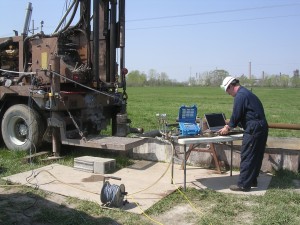We go beyond the dowsing rod and use hydrogeologic instruments to help locate water and reduce your re-drill costs. 
To locate groundwater accurately and to determine the depth, quantity, and quality of the water, several techniques must be used, and a target area must be thoroughly tested and studied to identify hydrologic and geologic features important to the planning and management of the resource. The landscape may offer clues to the hydrologist about the occurrence of shallow groundwater. Conditions for large quantities of shallow groundwater are more favorable under valleys than under hills. In some regions–in parts of the arid Southwest, for example–the presence of “water-loving” plants, such as cottonwoods or willows, indicates groundwater at shallow to moderate depth. Areas where water is at the surface as springs, seeps, swamps, or lakes reflect the presence of groundwater, although not necessarily in large quantities or of usable quality.
Geology is the key
Rocks are the most valuable clues of all. As a first step in locating favorable conditions for groundwater development, the hydrologist prepares geologic maps and cross sections showing the distribution and positions of the different kinds of rocks, both on the surface and underground. Some sedimentary rocks may extend many miles as aquifers of fairly uniform permeability. Other types of rocks may be cracked and broken and contain openings large enough to carry water. Types and orientation of joints or other fractures may be clues to obtaining useful amounts of groundwater. Some rocks may be so folded and displaced that it is difficult to trace them underground.